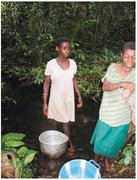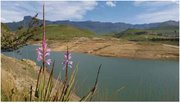Freshwater challenges and development in Africa
Contents
- 1 Introduction Pollution of rivers from industry is a growing problem in many parts of Africa. (Source: M. Chenje) Climate change (Freshwater challenges and development in Africa) and variability, population growth and increasing water demand, overexploitation and environmental degradation will continue to contribute to a worsening of the state of freshwater systems. In 2000, the United Nations noted that, "Global freshwater consumption rose sixfold between 1900 and 1995 – more than twice the rate of population growth. About one-third of the world’s population already lives in countries considered to be water stressed – that is where consumption exceeds 10 percent of supply. If present trends continue, two out of every three people on Earth will live in that condition by 2025."
- 2 Safe drinking water and sanitation
- 3 Food security
- 4 Public health
- 5 Environmental degradation
- 6 Financial resources
- 7 Further reading
Introduction Pollution of rivers from industry is a growing problem in many parts of Africa. (Source: M. Chenje) Climate change (Freshwater challenges and development in Africa) and variability, population growth and increasing water demand, overexploitation and environmental degradation will continue to contribute to a worsening of the state of freshwater systems. In 2000, the United Nations noted that, "Global freshwater consumption rose sixfold between 1900 and 1995 – more than twice the rate of population growth. About one-third of the world’s population already lives in countries considered to be water stressed – that is where consumption exceeds 10 percent of supply. If present trends continue, two out of every three people on Earth will live in that condition by 2025."
The overexploitation and regulation of water resources have caused significant changes in the flow regimes of rivers, resulting in negative impacts on the environment and loss of ecosystem functioning. Poor land-use practices have resulted in pollution and sedimentation of river channels, lakes and reservoirs, and changes in hydrological processes. Dams, in particular large dams, threaten freshwater resources by fragmenting and transforming aquatic systems. The region is marked by a recurrence of climatic extremes in the form of flooding and drought. Global change scenarios predict a continuing global warming for this century of between 1° and 6°C, a sea-level rise of between 0.1 and 0.9 m, and an increasing frequency of climatic extremes that may further aggravate the state of available freshwater resources.
Not only is the quantity of freshwater fundamental for the development of all sub-regions, but the quality of the resource is equally important. Deterioration of the quality of water resources resulting from further increases in salinity and nutrient loads from irrigation (irrigated agriculture) and the domestic, industrial and mining sectors will significantly deplete available resources and increase water scarcity. Increased human activities lead to the exposure of the water environment to a range of chemical, microbial and biological pollutants as well as to micro-pollutants. The mining and industrial sectors, in particular, produce high concentrations of wastes and effluents that act as nonpoint sources of water quality degradation and acid mine drainage. Increased groundwater pollution is a particular concern for the more arid countries.
Safe drinking water and sanitation
Despite improvement in the coverage for drinking water supply between 1990 and 2002, the coverage still falls short of the progress needed to achieve the Millennium Development Goal (MDG) target of 75 percent coverage by 2015. Regarding the MDG sanitation target, the situation is critical, though Northern Africa is almost on track in meeting both targets.
Poor sanitation, unsafe water and unhygienic environments are a leading cause of illness and death among children in Africa and cause millions of children in the developing world to suffer needlessly from disease.
Obstacles to accelerating the rate of progress towards the MDG targets in all sub-regions, with the exception of Northern Africa, include, as stated above, political instability, high rates of population growth and the subsequent increased demand from the agricultural and domestic sectors, and the low priority given to water and sanitation in terms of investment in infrastructure and maintenance.
Food security
Currently, huge losses due to crop failures, arising from droughts and flooding, are being experienced more frequently than ever before in Africa, causing famines and economic hardships. Insufficient investment and operational funds for irrigation infrastructure is a major constraint. In Eastern Africa, as elsewhere, there is a pressing need for development strategies that ensure food security. There is a growing pressure also on Southern Africa’s water from the growing population and the major sectors of the different economies. In Western Africa, agricultural production will have to rise rapidly in the coming years to secure food and nutrition for the population. Meeting water needs for food security is therefore an important challenge.
Public health
Africa has relatively high morbidity and mortality rates concerning water-borne and water-related diseases, such as malaria, cholera and diarrhoea. It also has the highest incidence of HIV/Aids in the world (up to 36 percent in Southern Africa). The implications of these diseases are enormous and affect the water sector in terms of water demand and supply, sanitation and human resource capacity (including service provision). Any decline in drinking water quality and inadequate sanitation facilities will lead to increased health risks, particularly for those people with compromised immune systems.
Environmental degradation
Environmental degradation in surrounding ecosystems and of freshwater bodies threatens water quality and the opportunities derived from them.
For countries relying on hydropower generation for their electricity supply, environmental degradation is a serious concern. Hydropower generation requires the reliable flow of water for most of the time (wet and dry seasons). Among the many factors leading to the degradation of watershed ecosystems, dams are the main physical threat. They fragment and transform aquatic and terrestrial ecosystems with a range of effects that vary in duration, scale and degree of reversibility. Degradation of the catchment area’s environment results in the decline of springs, streams and rivers, with catastrophic consequences for human welfare and environmental integrity.
Pollution of water resources is also a great concern as it is a threat to both the environment and the availability of freshwater. Agricultural chemical use contributes to pollution of rivers and lakes, including eutrophication which threatens aquatic life. The burning of biomass contributes to the atmospheric deposition of nutrients into freshwater systems. This can promote the formation of blue-green algae, which is toxic and potentially poses a health hazard to domestic animals, aquatic life and people.
Invasive alien species threaten freshwater resources, undermining their sustainability and contribution to livelihoods.
Financial resources
The World Panel on Financing Water Infrastructure noted that the flow of financial resources for water and sanitation has fallen over the last years. Governments have not been giving enough priority or resources to their water sector, international loans and equity investment in water have been low and falling, and official aid for the water sector has also fallen. This trend constitutes a huge challenge, and must be reversed if water resource development goals are to be achieved.
A further challenge is that many water sector agencies are not adequately prepared for absorbing increased funding. A major effort of capacity-building is thus required to strengthen the public sector in the preparation and implementation of projects and programmes, including those involving private participation. The absence of economic incentives and appropriate price regulation may not encourage resource users and polluters to take conservation or other measures. In Northern Africa, for instance, irrigation water has been provided free of charge to farmers and consequently no conservation measures are taken by them. Another issue is the effective allocation and use of governments’ budgets. Due to capital shortage, only part of the potential for irrigation in Africa could possibly be reached. One major problem that water authorities are faced with is the low collection of water revenues and the use of flat-rate charging for water services. Regarding the latter, water meters may be used to encourage efficient use of the scarce resource and to reduce wastage. Small water-supply and sanitation providers, such as community-based organizations (CBOs) and privatesector suppliers, play an important role in the water and sanitation sector. However, these providers are faced with problems related to finance and access to credit facilities.
Further reading
- Annan, K.A., 2000. We the Peoples:The role of the United Nations in the 21st Century. United Nations Department of Public Information, New York.
- Ashton, P. and Ramasar, V., 2002. Chapter 16: Water and HIV/AIDS: some strategic considerations in southern Africa. (Freshwater challenges and development in Africa) In hydropolitics in the Developing World: A Southern African Perspective (eds.Turton,A. and Henwood, R.), pp 217-35. African Water Issues Research Unit, Pretoria.
- Chenje, M. (ed. 2000). State of the Environment Zambezi Basin 2000. Southern African Development Community/IUCN – The World Conservation Union / Zambezi River Authority / Southern African Research and Documentation Centre, Maseru/Lusaka/Harare.
- Gordon, B., Mackay, R. and Rehfuess, E., 2004. Inheriting the World: the Atlas of Children’s Environmental Health and the Environment. World Health Organization, Geneva.
- IPCC, 2001. Climate Change 2001: Synthesis Report. A Contribution of Working Groups I, II, and III to the Third Assessment Report of the Intergovernmental Panel on Climate Change (eds.Watson, R.T. and the Core Writing Team). Cambridge University Press, Cambridge
- S & E Bulletin, 1999. Biodiversity in Lake Malawi. The Science and the Environment Bulletin, March/April.
- UNEP, 2006. Africa Environment Outlook 2
- WCD, 2000. Dams and Development:A New Framework for Decisionmaking, The Report of the World Commission on Dams. Earthscan Publications, London.
- WRI in collaboration with UNEP, UNDP and the World Bank, 2005. World Resources 2005: The Wealth of the Poor – Managing Ecosystems to Fight Poverty. World Resources Series.World Resources Institute, Washington, D.C.
- WWC, 2003. Financing Water for All. Report of the World Panel on Financing Water Infrastructure. World Water Council, 3rd World Water Forum and the Global Water Partnership.
|
|
| Disclaimer: This article is taken wholly from, or contains information that was originally published by, the United Nations Environment Programme. Topic editors and authors for the Encyclopedia of Earth may have edited its content or added new information. The use of information from the United Nations Environment Programme should not be construed as support for or endorsement by that organization for any new information added by EoE personnel, or for any editing of the original content. |



